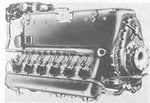- Thread starter
- #41
B-17engineer
Colonel
The only thing I have an issue with is the visibility. When landing the tailwheel is still on the ground (therefore impeded visibility.) and as in the picture I posted the propeller would have been lower in the plane than a regular V engine, could a lower propeller cause an different in the aircraft performance?

